Zane has just crossed all the current triple-cylinder Yamaha's off his test list. Check out what he thought of the heavily updated 2022 Yamaha XSR900... Photos: Impact Photography.
It has retro looks but there is nothing retro about the tech on the 2022 Yamaha XSR900! The heart, frame and suspension from the MT-09 with the electronics of the YZF-R1M, in an awesome package that pleases all those complaining about how the MT-09 looks…

The 2022 Yamaha XSR900 has the heart, frame and suspension of the MT-09 with the electronics of the YZF-R1M, jammed into an awesome looking package…
Check out Zane’s review of the 2021 MT-09 here…
The MT-09 was one of the coolest and unique machines I have had the pleasure of riding on a track at The Farm back in 2021. Its lightweight nature and insane mid-range from the three-cylinder made for easy work tackling the seemingly endless number of turns the private Central-Coast track had to offer. However, people soon flocked to the internet with their opinions on how they didn’t like how the front looked, granted the MT-09 was never the greatest looking bike but it looked heaps better in-person.
Enter the XSR900, reminiscent of the days when the Australian roads seemingly had no rules compared to my generation and you could double the speed limit on your XS1100 or in your dads VC Commodore. These are stories I hear from people twice my age, now riders are kept in a cage with EURO regulations and the strictest road-rules in the world. Throwing a leg over the XSR900 soon blasted away the bubble wrap that NSW riders are wrapped in.

“The 2022 XSR900 is a trick looking bit of kit. This year, it seems that Yamaha are playing more on their new favourite buzz-word of “neo-retro” instead of just a retro machine.”
The 2022 XSR900 is a trick looking bit of kit. This year, it seems that Yamaha are playing more on their new favourite buzz-word of “neo-retro” instead of just a retro machine. Compared to the XSR700 Luca tested recently, which looks like and RD350, it’s definitely not a modern take on anything in Yamaha’s ’80s line-up, it looks like a new bike and an old machine at the same time. There’s no single thing that makes it look new, it’s the combination of the big engine, lack of chrome, TFT and that sky-blue. I digress though, it’s still an amazing looking bike.
The hero-colour of “Legend Blue” looks like nothing else on the road, you can spot it from a mile away, but it doesn’t scream “Yamaha” surprisingly, it’s just a slight different shade of blue compared to “Yamaha blue”. The Bronze and Blue combination is heavily overlooked with over brands, I think it looks absolutely stunning.
Up the front is the first evidence that the bike isn’t actually from the 1980s with it’s LED light that has a cool steampunk look, held on by what looks like something out of a Meccano set. Compared to the XSR700, the 900 light seems to be smaller, which compacts the front-end similarly to the MT-09.
Behind that is the gorgeous, massive, blue tank that drops off hard down to the seat. The seat is the main aspect that calls on the old-school racers, with its cradling seat and tall pillion section. LED lighting all round, ‘bar end mirrors and that extraordinary engine as the centre-piece, overall bellissimo!
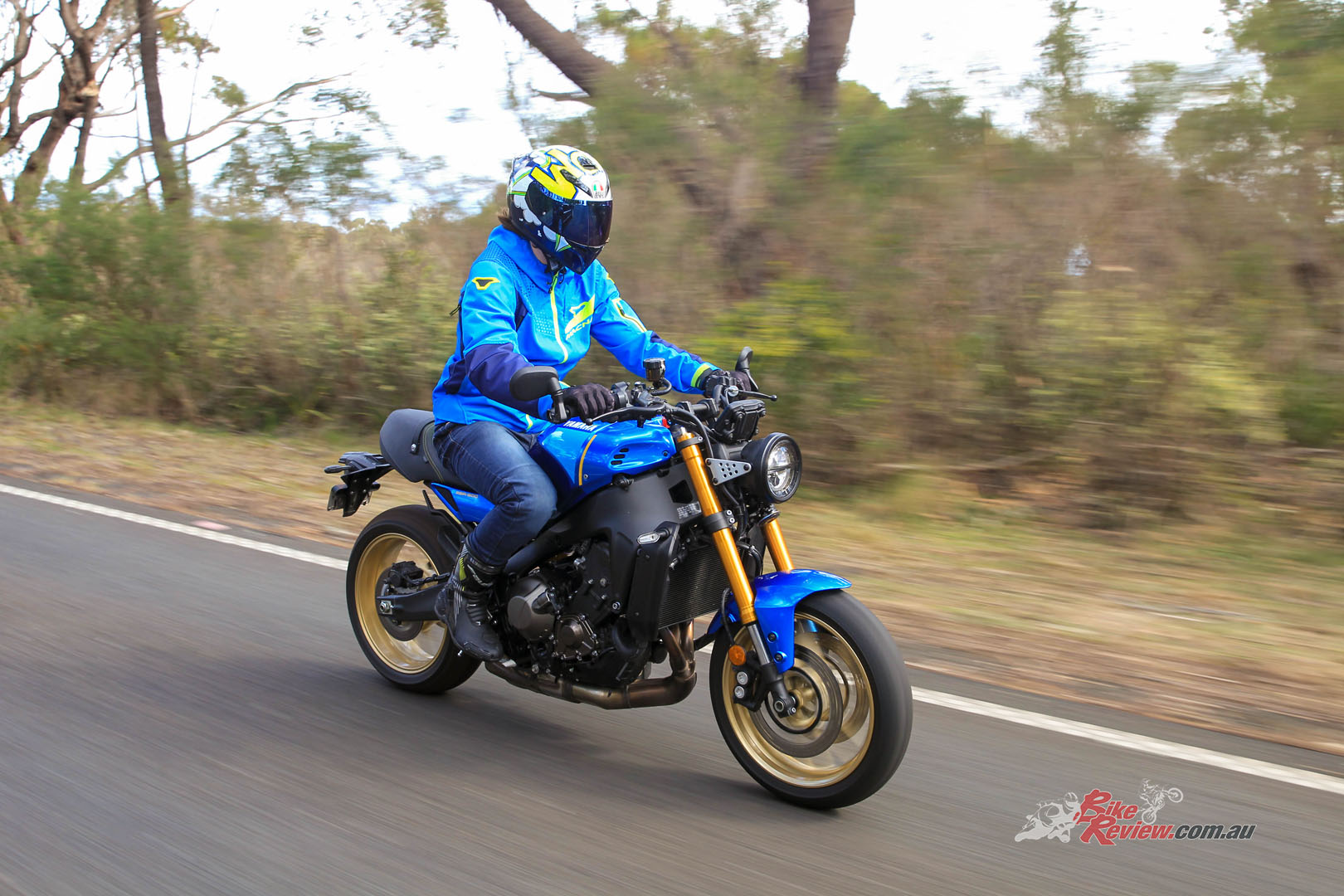
“The gearing and engine work in harmony to bring an awesome cruise control system that doesn’t stagger at all in overall speed.”
Time to jump on the updated model for the first time and what seems to be a common theme with my reviews of the last few months, I’m greeted with wet roads! Hey, at least it’s a good chance to check out the six-axis system that made its way from the 2020 MT-09 onto the XSR900.
Leaving Yamaha and jumping straight onto the freeway meant cruise control set to 100km/h for an hour or so, the gearing and engine work in harmony to bring an awesome cruise control system that doesn’t stagger at all in overall speed, hit a hill and the computer opens the throttle gently so it’s not constantly trying to catch up to your set speed, while the downhills had plenty of engine braking so you’re constantly exactly on the speed limit.

Yamaha have got their assist system down-pat. Applying what they’ve learnt from MotoGP onto a lot of their higher-end road machines!
Hitting the twisties for the first time and all the assists are turned up to max because of the patchy roads, but the power mode is on full. Not once did the rear wheel want to slip out under heavy acceleration nor through the corners. I’ve always had the thought that a good assist system wont show itself until you really need it and the XSR900 just trundles along like all the assists are switched off.
“I’ve always had the thought that a good assist system wont show itself until you really need it and the XSR900 just trundles along like all the assists are switched off…”
With the roads drying up, the opportunity was finally there to see how different that six-axis assist system really handles things. Switching everything off, I’m greeted with this absolute wild animal of a bike. Low RPM and everything is fine, then all of a sudden, the three-cylinder seems to burst into life! Throwing the front wheel up in the air with such vigor that I had to tap the rear brakes, which slammed my nuts into the tank as the wheel hit the ground!

“Switching everything off, I’m greeted with this absolute wild animal of a bike. Low RPM and everything is fine, then all of a sudden, the three-cylinder seems to burst into life!”
Alright, maybe time to be a bit more gentle with a 117hp bike that weighs under 200kg. Despite not having issues with how the bike performed with no assists, I ended up opting to put the LIF and TCS on for the rest of the test just to eliminate that mental barrier and possibility that there could be a sudden loss of control and kick in the nuts.
The LIF system works spectacularly, as someone who sucks at wheelies, it allowed for a controlled and relatively high wheelie. The mid-range torque and power levels make it hard to control that wheelie balance point without it on but thanks to the six-axis IMU, it won’t let you over rotate and land on your ass with a brand-new bike sliding down the road without you.
The sound that comes out of the 889cc is spectacular, the unequal length headers compliment the uneven firing order of the crossplane crank setup to make the noise like nothing else on the road. Rip that muffler off and put a respectable slip-on muffler on the end and you’ll have one of the best sounding new bikes on the road! Combine this with the fact that those electronic throttle-bodies that suck in more air than a Dyson vacuum cleaner and the XSR900 sounds extremely angry on song.
“Combine the unequal length headers with those electronic throttle-bodies that suck in more air than a Dyson vacuum cleaner and the XSR900 sounds extremely angry on song.”
Yamaha have updated the clutch for 2022 too, as is the case with the MT-09 and Tracer 9 GT, the XSR900 prefers a few more revs than other bikes in the same class. When it comes to lane splitting and slow riding the slipper and assist clutch shines as a combo of rear brake and clutch dragging makes it easy to ride at almost a stand-still.
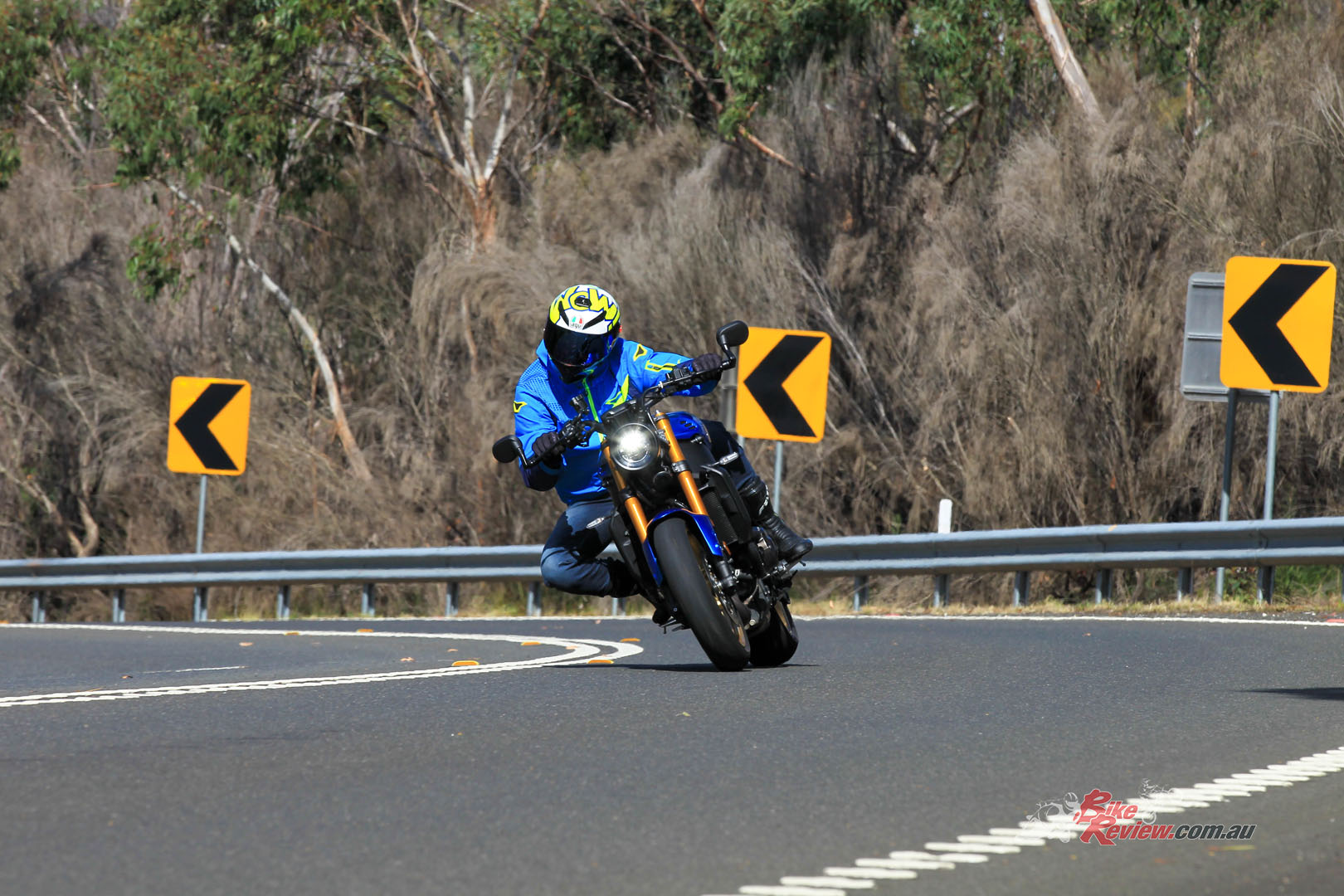
The sound is addictive! You’ll find yourself with the throttle constantly cranked to hear the growl of the triple.
The gearbox ratios are well suited for Australian roads and the odd track day. It’s quite refreshing to be able to cruise around in third without shifting up and down but the quickshifter on the higher end Yamaha’s are so addictive. I’d love to get a time machine back to the 1980s and throw an old-school rider on this thing to watch their reactions as the triple soars through the gears at full pelt without hesitation. It sounds so aggressive as you rattle through the gears, yet feels as if the cogs have been massaged into place. Down shifts are even more insane as you tap your foot down while the engine pops and yells at the top of its lungs. Simply, mechanical bliss…
Check out Zane’s Tracer 9 GT review here…
On daily duties, the 2022 XSR900 struggles a little with providing rider comfort. My test route consists of a six hour loop, a few hours on the freeway and a few hours on the twisties. The freeway sees a slightly harsh rebound from the rear end with the weather destroyed roads of NSW, combined with the seat made from “Yamahadian” (a term I’ve coined to describe the material that Yamaha make their seat from, firmer than marble) made for a sore arse and lower back after my test loop.

Touring on the 2022 XSR900 left a little to be desired. The firm seat and harsh rear shock would be the first on my lift to change if I owned one.
The preload and rebound are adjustable for the KYB shock at the rear which is an option if you’re going to be touring every day, but finding that sweet spot of performance and comfort for my test loop seemed to just be the stock settings.
The front-end is a different story, an extraordinary match of comfort and performance through the KYB forks, which are fully adjustable but didn’t need any changes. Under brakes, the forks remain stable and don’t dive too much. Seriously underrated piece of kit which I noted felt awfully similar on the road when comparing the electric suspension on the MT-09SP to the base MT-09!

“The chassis is spectacular, the XSR900 feels like it’s about 50kg less than what Yamaha claim it to be. It’s such an easy bike to ride fast”.
The chassis is spectacular, the XSR900 feels like its about 50kg less than what Yamaha claim it to be. It’s such an easy bike to ride fast and has lightning-fast direction changes. The seating position may take a little while to get used to with the rear cowl compared to the MT-09 but once you do, you’ll have no issue getting the bike cranked on its side. A low speeds, XSR900 retains that feather-weight steering you feel at high speeds, I have no idea how they made it so easy to manoeuvre but it’s like those KYB forks weigh nothing. It’s not fatiguing to ride and everything feels sturdy.
The 3.5in TFT dash is also new for 2022, It would’ve been cool to retain the circle dash setup seen on previous models but added a full-colour setup but I can see why Yamaha opted to just run with a setup they use on other models. As is the case with the MT-09 and MT-10, the software does take a bit of getting used to. The assists are hidden in the menu but once you figure out how to use it, it’ll only take a few minutes to set up some presets that you can switch between via the buttons on the handlebars.
The brakes are stunning once again, the twin discs at the front are now 298mm, which will make you feel sick while slamming them on. The ABS system that uses the Yamaha brake control system allows for copious amounts of trail braking and emergency mid-corner stoppage without dropping the bike. The rear setup has a great feel to it that allows for easy slow speed riding.

“The ABS system that uses the Yamaha brake control system allows for copious amounts of trail braking and emergency mid-corner stoppage without dropping the bike.”
It’s hard to find the words to describe what an awesome ride the 2022 XSR900 is. Everything about it is addictive in its own way, from the mid-range torque that flings the front wheel in the air to the six-axis assist system that stops you from making a fool of yourself when it catches you off guard.
Yamaha have made an awesome base for a mass-produced bike that you can modify into something that looks like nothing else on the road with very little effort…
I think the most important thing is that Yamaha have made an awesome base for a mass-produced bike that you can modify into something that looks like nothing else on the road with very little effort. It appeals to the crowd that weren’t a fan of the MT-09 styling or the Tracer 9 GT. Most importantly, it’s not trying to be something it isn’t, a classic bike, it has its own vibe that impresses me each time I hit the starter and put the visor down.
Starting at $17,299 rideaway it’s battling directly with the Z900RS, which has a more basic electronics setup but encompasses the retro look entirely. Deciding between the two will really come down to if you want a classic bike with the reliability of a modern one or a modern bike that has slight styling queues from the 1980s but MotoGP technology.

The 2022 Yamaha XSR900 appeals to the crowd that weren’t a fan of the MT-09 styling or the Tracer 9 GT.
Sure, there are a few things that put me off really wanting the new XSR900. As stated above, most of which could be changed to my liking with some simple modifications. It would be insanely cool if there was an SP version of the XSR900, mainly for the rear shock, but then it really loses track of what the XSR range is all about.
2022 YAMAHA XSR900 TECH TALK

The Crossplane three motor has been entirely changed for 2021. From its capacity all the way to how much it weighs.
CP3 ENGINE
The Crossplane three engine retains the concept of the old model: In line triple with forged pistons, offset cylinders and fracture split rods. All designed to handle high stress running. But the Yamaha engineers have changed virtually every component within it to enhance performance, efficiency and character. The crankshaft was redesigned to increase the inertial mass by 15 per cent.
By redesigning and repositioning the fuel injectors, Yamaha reduced the camshaft overlap and working angle. This lets them produce a cleaner burn in the cylinder that allows removal of the secondary air injection system, for less complexity and weight. Almost every component had been touched and despite the bigger cc, total weight of the engine has been reduced by 1.7kg
CHASSIS
Featuring 41mm tubes with a tough DLC (Diamond Like Carbon Coating) that Yamaha say ensures ultra-smooth and responsive suspension action, the premium specification KYB front forks feature adjustability for preload, rebound, and compression damping enabling the rider to set-up to suit different riding situations.
Longitudinal, lateral and torsional rigidity are all significantly increased, resulting in better straight line stability together without affecting agility. The head pipe is located 30mm lower than the previous model for increased feeling when cornering. This allows the handlebars to be mounted lower to give the XSR900 a more aggressive stance. Combined with other changes to the chassis there is a 14 per cent reduction in inertia around the steering axis compared to the previous model – enabling the rider to corner quickly, accurately and confidently.

Yamaha have lowered the front-end by a massive 30mm. Yet they have retained the same amount of travel.
ELECTRONICS
The 2021 features a new 6-axis IMU for lean sensitive rider aids which is lighter and more compact than the R1 system. In this system, riders get Cornering Traction Control System [TCS], Slide Control System [SCS], Lift Control System [LIF] and Cornering ABS (BC). All of this is controlled through Bosch’s 9.1MP based system which allows the ride to set their profile to suit their style.
In addition to the electronic rider aids, riders can choose to activate cruise control at speeds of 50km/h or above, and in fourth gear or higher. Once the speed has been set, it can be increased in 2km/h increments by single pushes of the switch, or steadily increased by holding down the same switch. The system is cancelled whenever the brakes, clutch, or throttle are used.
Yamaha say the dash is Intentionally compact and minimalist, they wanted to focus on the riding ability of the bike, and not distract by applying excessive colour or design. An intuitive interface allows quick changes to the rider aids and throttle modes with the switches on the left had switch cluster while riding, while the key system information can be programmed through the scroll wheel on the right hand switch cluster when stopped, separately the active and passive functionality.

Yamaha say the dash is Intentionally compact and minimalist, they wanted to focus on the riding ability of the bike, and not distract by applying excessive colour or design.
2022 Yamaha XSR900 Specifications
Price: $17,299 rideaway
Warranty: Two-years unlimited km
Colours: Legend Blue, Midnight Black
Claimed Power: 87.5kW@10,000rpm
Claimed Torque: 93Nm@7000rpm
Wet Weight: 193kg
Fuel capacity: 14L
Fuel Consumption Claimed: N/A
Fuel Consumption (measured): N/A
Engine: Liquid-cooled, four-stroke, DOHC, Cross plane triple, 78.0mm x 62.1mm bore x stroke, 889cc, 11.5:1 compression, three-into-one exhaust Gearbox: Six speed Clutch: Wet, multiple disc
Chassis: Frame: Aluminium Deltabox frame
Rake: N/A Trail: N/A
Suspension: USD 41mm telescopic KYB fork, fully adjustable (f), travel N/Amm, KYB monoshock, adjustable for preload and rebound (r), travel N/Amm.
Brakes: Twin 289mm discs with four-piston radial-mount calipers, Brembo master-cylinder, cornering ABS(f), Single 245mm disc with single-piston caliper, cornering ABS (r)
Wheels & Tyres: 10-spoke cast alloy wheels, 120/70 – 17 and 180/55 – 17 Bridgestone S22 tyres.
Dimensions:
Seat height: 810mm
Ground clearance: 140mm
Overall width: 860mm
Overall Length: 2155mm
Overall height: 1115mm
Max lean: N/A
Instruments & Electronics: Full-colour TFT dash, Cornering Traction Control System [TCS], Slide Control System [SCS], Lift Control System [LIF] and Cornering ABS (BC), Engine Modes, Cruise.
The Verdict | Road Test: 2022 Yamaha XSR900


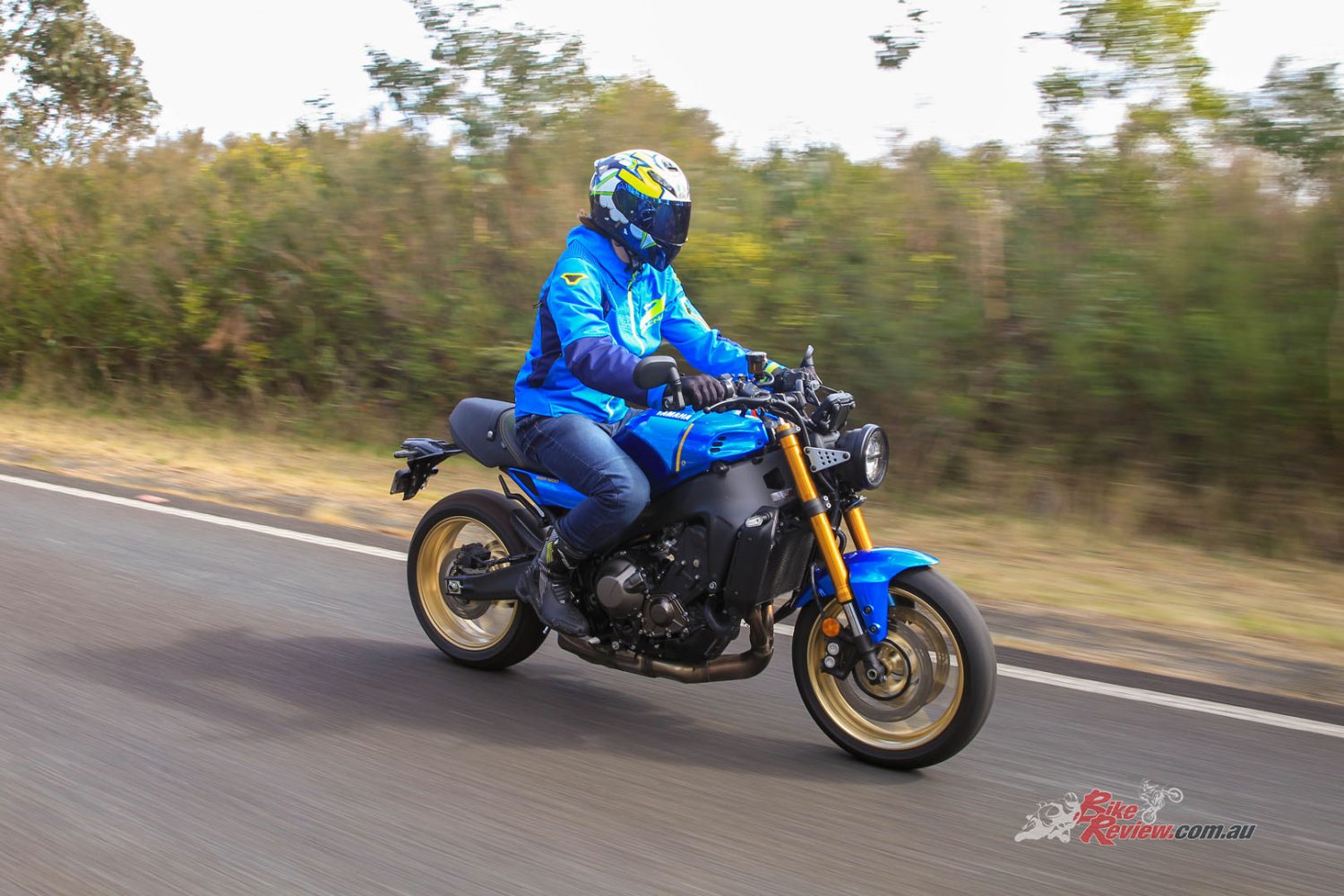




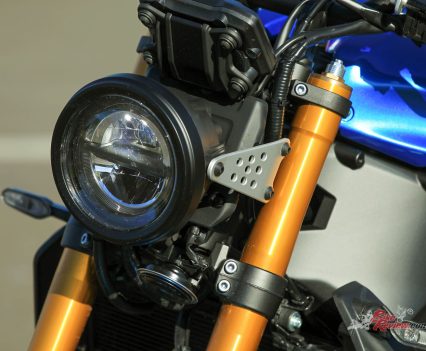







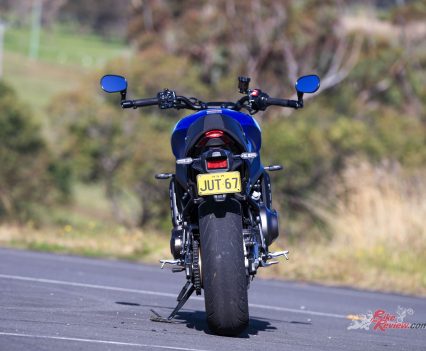


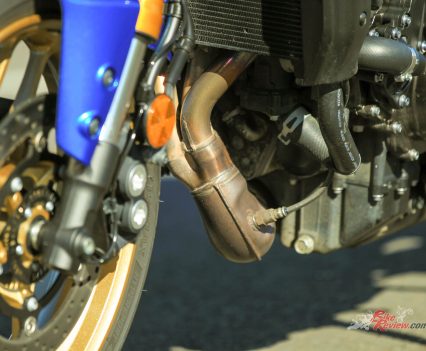


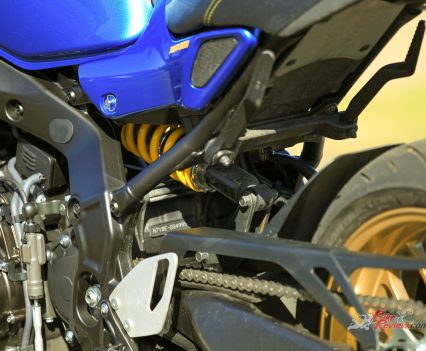












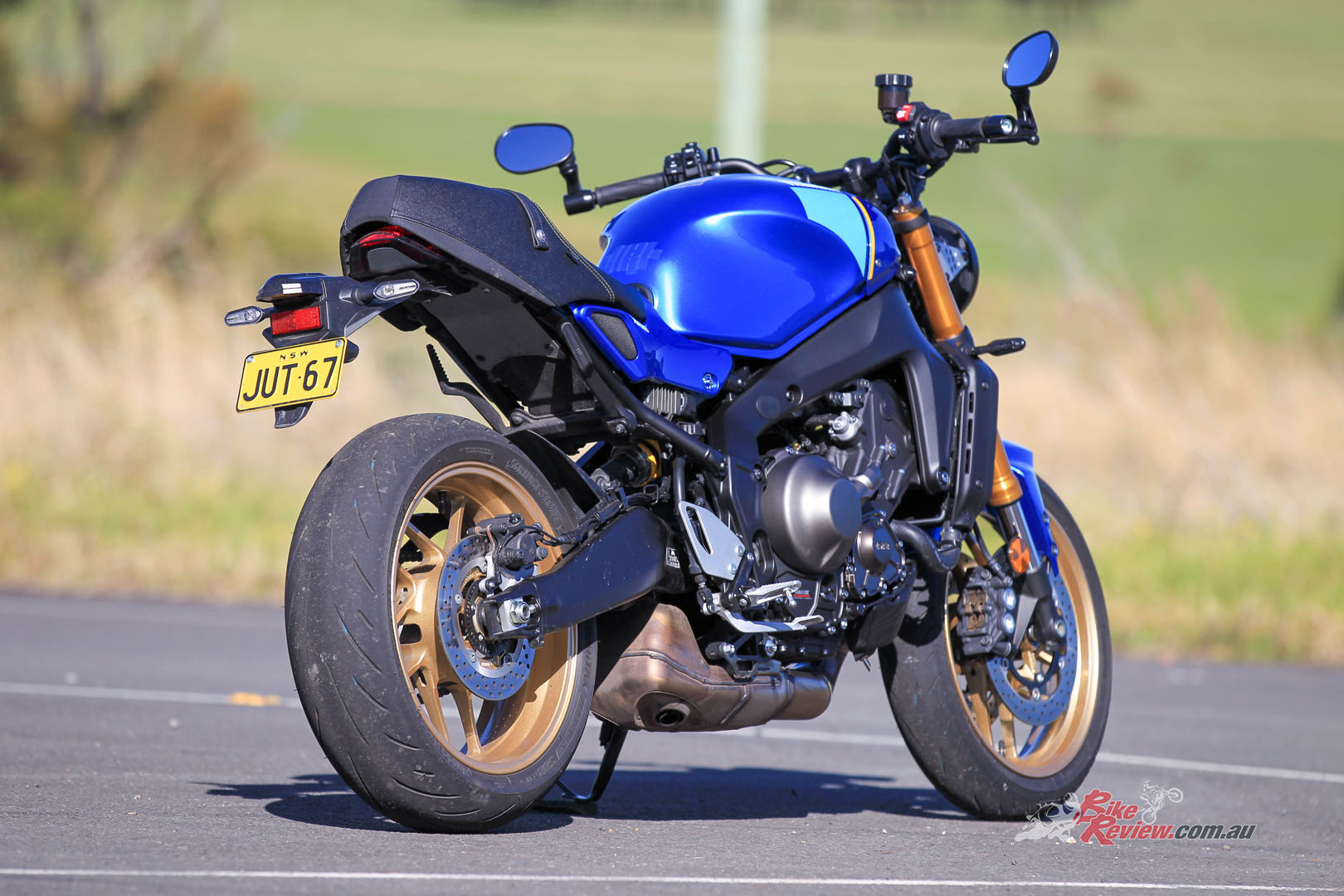
























October 23, 2022
My Impression was the XSR with longer swing arm, lower seat, longer each,
is a Canyon Cruiser.
While the MT09 is far superior in Urban areas.
Also the MT09SP suspension is not as good for tighter Urban streets as the standard MT09.
Finally suspension range on a bike is never specified by the manufacturers for rider weight.
August 21, 2023
I still love that some people think that cross plane has something to do with firing order. This bike has a perfectly even firing order, like almost every triple ever used in production.